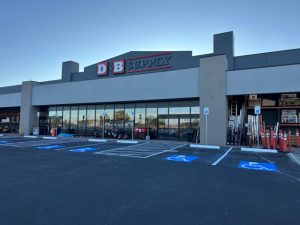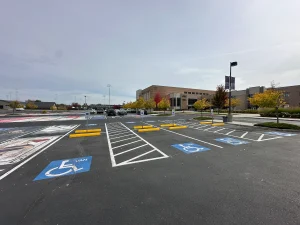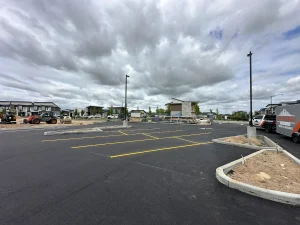How Hot Rubber is Used for Crack Filling: A Key to Long-Lasting Asphalt Repairs
Cracks are a natural part of an asphalt surface’s wear and tear, but if left untreated, they can lead to much larger and more expensive problems. One of the most effective ways to address these cracks is through hot rubber crack filling. This method is widely regarded as one of the best solutions for filling asphalt cracks because of its flexibility, durability, and resistance to the elements. In this blog post, we’ll explore what hot rubber crack filling is, how it’s applied, and why it’s essential for maintaining the longevity of your asphalt pavement.
1. What is Hot Rubber Crack Filling?
Hot rubber crack filling is a process in which a specially formulated rubberized asphalt sealant is heated and applied to cracks in asphalt pavements. This rubberized material is designed to expand and contract with temperature changes, allowing it to seal cracks effectively without becoming brittle in cold weather or melting in extreme heat.
The main purpose of hot rubber crack filling is to prevent water, dirt, and debris from seeping into the cracks and weakening the asphalt foundation. By sealing cracks early, you can stop them from expanding and turning into potholes or large areas of pavement failure.
2. How Hot Rubber Crack Filling is Applied
The process of applying hot rubber crack filler involves several important steps to ensure that the crack is sealed properly and lasts as long as possible. Here’s a step-by-step breakdown of how it’s done:
Step 1: Cleaning the Cracks
Before the hot rubber can be applied, the cracks must be thoroughly cleaned. Any dirt, debris, vegetation, or loose asphalt needs to be removed to ensure proper adhesion. This is typically done using high-pressure air or mechanical blowers to clear out the crack. If necessary, a wire brush or specialized crack cleaning tool can be used to get rid of stubborn debris.
Step 2: Heating the Rubberized Sealant
The rubberized asphalt material used for crack filling is heated to a temperature of approximately 350°F to 400°F using specialized equipment called a melter or kettle. This heating process makes the material pliable, allowing it to flow easily into the cracks and fill even the smallest gaps.
Step 3: Filling the Cracks
Once the rubberized sealant has reached the appropriate temperature, it is poured or injected into the cracks. This is usually done using a hot pour machine that allows for precise application, ensuring that the crack is completely filled and that the material bonds to the sides of the crack. Care is taken to avoid overfilling, as the goal is to achieve a flush surface with the surrounding pavement.
Step 4: Smoothing the Surface
After the crack is filled, a squeegee is often used to smooth the surface of the sealant and ensure it sits level with the pavement. This also helps to create a clean and uniform appearance.
Step 5: Cooling and Curing
Once the hot rubber is applied, it needs time to cool and harden. The material typically cools down within 15 to 30 minutes, depending on weather conditions. Once cooled, the crack filler forms a strong, flexible bond with the surrounding asphalt, creating a durable seal that can withstand the stresses of traffic and weather changes.
3. Why Hot Rubber Crack Filling is Effective
Hot rubber crack filling is widely considered one of the most effective methods for crack repair for several reasons:
- Flexibility: Asphalt naturally expands and contracts with changes in temperature. Hot rubber crack filler is designed to do the same, moving with the pavement as it heats up in the summer and contracts in the winter. This flexibility ensures that the crack remains sealed throughout temperature fluctuations, preventing further damage.
- Waterproofing: One of the primary reasons cracks in asphalt become a major problem is due to water infiltration. When water seeps into cracks, it can erode the subbase of the asphalt and cause freeze-thaw cycles during colder months. Hot rubber crack filling provides a watertight seal, preventing moisture from entering and causing further deterioration. This waterproofing quality is crucial for extending the lifespan of your asphalt surface.
- Durability: Unlike some cold-pour or quick-fix crack fillers, hot rubber crack filler creates a strong bond that lasts for years. It can withstand heavy traffic loads and doesn’t break down under harsh conditions like UV exposure or chemicals, making it ideal for high-traffic areas such as parking lots, roads, and driveways.
- Cost-Effective: By sealing cracks early using hot rubber, you can prevent larger, more costly repairs down the road. Crack filling is a fraction of the cost of repaving or resurfacing a damaged asphalt surface. It’s an investment that pays off by extending the life of your pavement and delaying the need for major repairs.
4. When to Use Hot Rubber Crack Filling
The best time to apply hot rubber crack filler is during the warmer months, typically in the spring through early fall, when temperatures are consistently above 50°F. This allows the crack filler to bond properly with the asphalt and ensures optimal performance. It’s also best to schedule crack filling after winter, as the freeze-thaw cycles can cause new cracks to form or expand existing ones.
5. Maintaining Your Asphalt with Regular Crack Filling
Regular crack filling is a key component of asphalt maintenance. Left untreated, small cracks can quickly turn into larger cracks, potholes, and other types of pavement failures that are much more expensive to fix. By addressing cracks early with hot rubber filling, you can:
- Prevent water damage and subbase erosion
- Maintain the appearance of your asphalt surface
- Extend the life of your pavement by several years
- Reduce repair costs by stopping cracks from growing larger
Conclusion
Hot rubber crack filling is a highly effective, flexible, and durable solution for sealing cracks in asphalt. By filling cracks early, you prevent water infiltration, reduce the risk of more significant damage, and extend the lifespan of your pavement. Regular crack filling with hot rubber is an investment in the health of your asphalt surface and a cost-effective way to protect it from the elements and daily wear and tear.
For best results, it’s important to choose the right time for application and work with professionals who can ensure that the cracks are properly cleaned, filled, and sealed for long-lasting protection.


